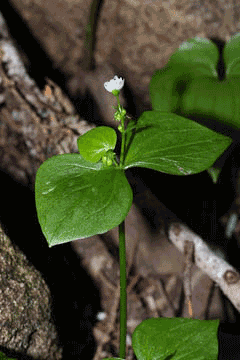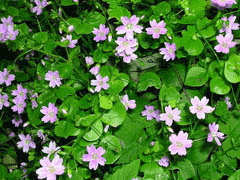 |
|
http://commons.wikimedia.org/wiki/User:Wsiegmund |
 |
|
Translate this page:
Summary
Note: Montia sibirica is a synonym of Claytonia sibirica.
Physical Characteristics

 Claytonia sibirica is an evergreen Annual/Perennial growing to 0.2 m (0ft 8in).
Claytonia sibirica is an evergreen Annual/Perennial growing to 0.2 m (0ft 8in).
See above for USDA hardiness. It is hardy to UK zone 3 and is not frost tender. It is in leaf all year, in flower from April to July, and the seeds ripen from June to August. The species is hermaphrodite (has both male and female organs) and is pollinated by Bees, flies. The plant is self-fertile.
Suitable for: light (sandy), medium (loamy) and heavy (clay) soils, prefers well-drained soil and can grow in nutritionally poor soil. Suitable pH: mildly acid, neutral and basic (mildly alkaline) soils and can grow in very acid soils.
It can grow in full shade (deep woodland) semi-shade (light woodland) or no shade. It prefers dry or moist soil.
UK Hardiness Map
US Hardiness Map
Synonyms
Claytonia alsinoides. C. sibirica.
Plant Habitats
Woodland Garden Sunny Edge; Dappled Shade; Shady Edge; not Deep Shade; Ground Cover;
Edible Uses
Edible Parts: Leaves
Edible Uses:
Leaves - raw or cooked[2, 62, 183]. They usually have a fairly bland flavour and are quite nice in a salad or cooked as a green vegetable. The leaves have a distinct earthy after-taste rather like raw beetroot[K]. They are available all year round but can turn rather bitter in the summer, especially if the plant is growing in a hot dry position[K]. Although on the small side, the leaves are produced in abundance and are very easily harvested[K].
References More on Edible Uses
Medicinal Uses
Plants For A Future can not take any responsibility for any adverse effects from the use of plants. Always seek advice from a professional before using a plant medicinally.
Antidandruff Diuretic Ophthalmic Poultice
The plant is diuretic[257]. A poultice of the chewed leaves has been applied to cuts and sores[257]. The juice of the plant has been used as eye drops for sore red eyes[257]. A cold infusion of the stems has been used as an antidandruff wash for the hair[257].
References More on Medicinal Uses
The Bookshop: Edible Plant Books
Our Latest books on Perennial Plants For Food Forests and Permaculture Gardens in paperback or digital formats.

Edible Tropical Plants
Food Forest Plants for Hotter Conditions: 250+ Plants For Tropical Food Forests & Permaculture Gardens.
More

Edible Temperate Plants
Plants for Your Food Forest: 500 Plants for Temperate Food Forests & Permaculture Gardens.
More

More Books
PFAF have eight books available in paperback and digital formats. Browse the shop for more information.
Shop Now
Other Uses
A good ground cover plant for a shady position[208]. This species is a short-lived perennial but it usually self-sows freely and gives a dense weed-excluding ground cover[K].
Special Uses
Food Forest Ground cover
References More on Other Uses
Cultivation details
A very tolerant and easily grown plant, it prefers a moist peaty soil[1] and is unhappy in dry situations[K]. It succeeds in full sun[200] though is happier when given some shade and also grows in the dense shade of beech trees[88]. Plants usually self-sow freely[200, K]. This is an excellent and trouble-free salad plant. It is extremely cold-hardy and can provide edible leaves all year round in all areas of the country even if it is not given protection[K]. Montia sibirica (L.) Howell is a synonym of Claytonia sibirica L. For polyculture design as well as the above-ground architecture (form - tree, shrub etc. and size shown above) information on the habit and root pattern is also useful and given here if available. A clumping mat former. Forming a dense prostrate carpet spreading indefinitely [1-2]. The root pattern is fibrous dividing into a large number of fine roots [1-2].
References Carbon Farming Information and Carbon Sequestration Information
Temperature Converter
Type a value in the Celsius field to convert the value to Fahrenheit:
Fahrenheit:
The PFAF Bookshop
Plants For A Future have a number of books available in paperback and digital form. Book titles include Edible Plants, Edible Perennials, Edible Trees,Edible Shrubs, Woodland Gardening, and Temperate Food Forest Plants. Our new book is Food Forest Plants For Hotter Conditions (Tropical and Sub-Tropical).
Shop Now
Plant Propagation
Seed - sow spring or autumn in situ. The seed usually germinates rapidly.
Other Names
If available other names are mentioned here
Native Range
TEMPERATE ASIA: Kamcatskij kraj (Komandorskiye Islands),Russian Federation. NORTHERN AMERICA: United States, Alaska, Idaho, Montana (west), Oregon, Washington, California (north), Canada, British Columbia,
Weed Potential
Right plant wrong place. We are currently updating this section.
Please note that a plant may be invasive in one area but may not in your area so it's worth checking.
Conservation Status
IUCN Red List of Threatened Plants Status :

Growth: S = slow M = medium F = fast. Soil: L = light (sandy) M = medium H = heavy (clay). pH: A = acid N = neutral B = basic (alkaline). Shade: F = full shade S = semi-shade N = no shade. Moisture: D = dry M = Moist We = wet Wa = water.
Now available:
Food Forest Plants for Mediterranean Conditions
350+ Perennial Plants For Mediterranean and Drier Food Forests and Permaculture Gardens.
[Paperback and eBook]
This is the third in Plants For A Future's series of plant guides for food forests tailored to
specific climate zones. Following volumes on temperate and tropical ecosystems, this book focuses
on species suited to Mediterranean conditions—regions with hot, dry summers and cool, wet winters,
often facing the added challenge of climate change.
Read More
Expert comment
Author
L.
Botanical References
1750270
Links / References
For a list of references used on this page please go here
Readers comment
| Add a comment |
|
If you have important information about this plant that may help other users please add a comment or link below. Only comments or links that are felt to be directly relevant to a plant will be included. If you think a comment/link or information contained on this page is inaccurate or misleading we would welcome your feedback at [email protected]. If you have questions about a plant please use the Forum on this website as we do not have the resources to answer questions ourselves.
* Please note: the comments by website users are not necessarily those held by PFAF and may give misleading or inaccurate information.
To leave a comment please Register or login here All comments need to be approved so will not appear immediately.
|
Subject : Claytonia sibirica
|
|
|
|